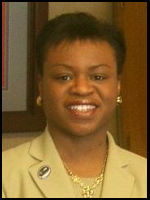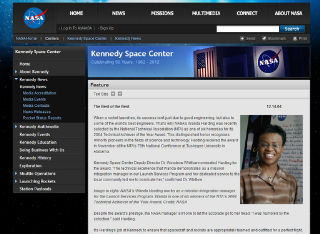NASA Mission Manager, Wanda Harding

Wanda Harding
Senior Mission Manager
Flight Projects Office
Launch Services ProgramWanda Harding is a senior mission manager in the Flight Projects Office of the Launch Services Program (LSP) at NASA's Kennedy Space Center in Florida, providing leadership in launch services project planning, development, analysis and forecasting.
The LSP serves as the "bridge from earth to space" for the NASA and NASA-sponsored science, exploration and technology demonstration missions. These missions, as described by NASA Administrator Charles Bolden, "...enable us to explore new worlds, develop more innovative technologies, foster new industries, increase our understanding of the earth, expand our presence in the solar system, and inspire the next generation of explorers..."
As a mission manager, Harding leads and manages a matrixed, multi-disciplined mission integration team of senior level engineers and business management personnel located at Kennedy Space Center and at Vandenberg Air Force Base in California. She is the mission manager for the upcoming Mars Science Laboratory (MSL) and the Tracking, Data, and Relay Satellite K & L (TDRS-K and TDRS-L) missions.
Harding's prior mission management experience includes, during various phases of formulation and implementation, the secondary payload missions Oersted, SUNSAT, Munin, and Citizen Explorer; and the primary missions Spitzer Space Telescope, Gravity Probe-B (GP-B), Ocean Surface Topography Mission (OSTM), Aeronomy of Ice in the Mesosphere (AIM), Demonstration of Autonomous Rendezvous Technology (DART), Dawn, Interstellar Boundary Explorer (IBEX), Lunar Reconnaissance Orbiter (LRO), Lunar Crater Observation and Sensing Satellite (LCROSS), Landsat Data Continuity Mission (LDCM), and the Solar Dynamics Observatory (SDO).
Prior to joining LSP, Harding held a variety of technical positions in the Space Station Launch Site Support organization. She participated in the NASA Administrator's Fellowship Program, which included a one-year teaching assignment at Spelman College in Atlanta, Ga., and a professional detail at NASA Headquarters in Washington, D.C. Harding also served as an executive intern with the director of Kennedy Space Center.
Harding is a graduate of the Benjamin E. Mays High School Academy of Science and Mathematics in Atlanta, Ga. She earned a B.S. in electrical engineering from Hampton University in Virginia and received her M.S. in electrical engineering from the Georgia Institute of Technology in Atlanta. She joined the NASA team at Kennedy Space Center in 1994.
Few people have the ability to captivate people and hold them spellbound. Wanda Harding possesses that ability because she is one of a very few elite scientists that get to play in outer-space. Imagine...
DR: I am here today with Wanda Harding, Mission Integration Manager with National Aeronautics and Space Administration (NASA). Did I get that right Wanda?
WH: That was our old title. We just go by Mission Manager now.
DR: Can you tell me what exactly a Mission Manager is and what is it exactly that a Mission Manager do?
WH: I am a Mission Manager with The Launch Services Program down at The Kennedy Space Center. Our role is equivalent to a Project Manager. Our organization serves as basically the bridge from earth to space for NASA's spacecraft and satellite missions. There is a Mission Manager responsible for the team from the NASA side, that works with the spacecraft customer over a period of three to five years making sure that all the requirements are in place, that the launch vehicle is appropriate for the type of mission that is being launched and making sure that at the end of the day, when we launch the spacecraft, we insert it into its proper orbit and get it on its way. The exciting part with that job is of course the day of launch where you actually get a chance to sit on console after working the mission for a number of years...
DR: Wow...
WH: And you are part of The Launch Management Team that gets to give that final "go" as we are going into terminal count for the mission.
DR: What is that like?
WH: In one word "It's amazing".
The first thought that captures you is
"Woo! Okay, we are finally here".
But then, the next thought, like in the case of the Mars Mission, when you realize that you are about to send something, not just off the planet, but to another planet. That is a whole different layer of excitement that is generated.
DR: Is there anything that you can compare that to for us earthlings?
WH: Oh my goodness. I would say that the thrill is probably like the first time you got to drive the car by yourself or whatever momentous occasion where you have waited and put a lot of effort behind it and its finally here. But I don't think that does it justice. I think the next best thing is to actually experience a launch in person. Watching it on TV is one thing but when you are actually out there and can feel the rumble as it is going up - it's just amazing.
DR: I am wondering if a big part of what has it feel so amazing is, what I would imagine, a tremendous sense of responsibility for meeting the objective and for the results that you want to achieve.
WH: That has a lot to do with it. For my job and what I do, our most important thing is safely separating the spacecraft from the launch vehicle and to get to that point, we have done a lot of testing. A lot of analyses goes into preparing for the mission.
From the scientist perspective, they have spent a lot of years and have done a lot of research getting the science instruments in place, looking forward to actually operating the mission. The last thing that you want to happen is for the launch vehicle, in any way, to compromise the spacecraft. And then you want to make sure that once you separate it you are putting it on its correct path, whether its earth orbiting satellite, whether its interplanetary where you are putting it on a hyperbolic departure orbit, getting it just right takes a lot of hard work and that is what makes the launch so exciting - you have done all of this preparation, you have done all of the testing, you have done all of the analyses and now you are ready for implementation.
The Best of the Best
Wanda Harding
When a rocket launches, its success isn't just due to good engineering, but also to some of the world's best engineers. That's why NASA's Wanda Harding was recently selected by the National Technical Association (NTA) as one of six honorees for its 2004 Technical Achiever of the Year Award. This distinguished honor recognizes minority pioneers in the fields of science and technology. Harding received the award in November at the NTA's 76th National Conference at Tuskegee University in Alabama.
Kennedy Space Center Deputy Director Dr. Woodrow Whitlow nominated Harding for the award. "The technical excellence that Wanda demonstrates as a mission integration manager in our Launch Services Program and her dedicated service to the local community led me to nominate her," confirmed Dr. Whitlow.
"I was humbled by the selection," said Harding.
It's Harding's job at Kennedy to ensure that spacecraft and rockets are appropriately teamed and outfitted for a perfect flight. Harding held the position for the Gravity Probe B mission launched in April. Following that mission, Harding's current assignment is with the Demonstration of Autonomous Rendezvous Technology (DART) mission. DART is an experiment in computer-guided spacecraft and due to launch from California in spring 2005.
[The NTA was founded in 1925 by an engineer named Charles S. Duke, who was the first African-American to receive an engineering degree from Harvard University. The Association is dedicated to encouraging minority participation in science and technology.]
(source: http://www.nasa.gov/centers/kennedy/news/wanda_harding.html)
DR: Can you talk about what some of the objectives are with regard to some of the more recent missions? What exactly is NASA trying to accomplish? The last spacecraft went to Mars?
WH: The last one went to Mars and that is the one that I feel comfortable talking about.
We have been going to Mars, as far as sending satellite and spacecraft, since the mid 1960s. With each trip, the purpose is to gather more and more information. Ultimately we would like to be able to send a human expedition to the planet but because earth is the only planet in our solar system that can accommodate human life - anywhere else we go we have to simulate the environment. So when you are planning a trip to another planet, the more you know about it the better prepared you can be because now you have to make sure that the technology is in place to provide those accommodations to make up for the deficiencies of not having the convenience of Earth's environment.
So, for the latest Mars mission, I like to describe it as a geologist in a self contained laboratory. It is searching for habitability basically proving (or at least demonstrating) that life could have existed in the past or it's able to accommodate it now. So with a series of science instruments that will allow it to gather samples and take data and send that back to the scientists at the jet propulsion laboratory or through the images that come back, they will be able to use this information to confirm some theories to identify and better characterize the planet and give us a better understanding of this latest location that they have identified which is Gill Crater. The landing from Mars - it is going to take eight and a half months to get there. It will launch on the 26th of November and it's going to arrive on the 6th of August and the mission duration itself is about one Martian year. It averages out to about twenty-three months for the first time if you relate it back. It will be some very interesting information that comes back and hopefully it will prepare us for that next step. We have another Mars mission coming up in 2013, which will be an orbiter, but this one was unique because the Mars science laboratory rover will actually traverse the surface of the planet. It's going to be some neat stuff.
DR: Now are you responsible for monitoring the spacecraft while it is in orbit?
WH: Actually, yes. For clarification, there are a team of engineers who actually manage the build and development of the spacecraft. They are based out of the jet propulsion lab in California. We will keep up with what is going on however my basic job ended when the spacecraft successfully separated from the launch vehicle.
DR: Wow. That really must have been exciting...
WH: It was very exciting. We were able to have live video coverage of the separation event. I can't put words to it but seeing a spacecraft leave the launch vehicle and head on its destination is an awesome view.
DR: Are you optimistic that, one day, man will be able to live on a planet that is not Earth?
WH: I think so. I look at my niece who is eight and their generation and I think that they will probably be the ones that have the technology in place and be able to take that next step of a human expedition to another planet. It sounds crazy sometimes when you think about it.
You can't deny the fact that there is this human drive to just know more and experience what is going on when you consider the vastness of our Universe. Something inside of me says,
"There has got to be more".
This just gives us another opportunity to peer further into creation and see what is happening.
DR: That doesn't sound any crazier now than I would imagine "Man on the moon" sounded when President Kennedy first said that.
WH: I would think so. You will have your doubters but once you get there and you are recognizing there are really no true limitations to what we can do, you allow that creativity to flow and get out there. The technology is there.
The satellites and other orbiters that we have been able to send up from NASA have added new chapters to the science books. We are still writing new chapters. It's exciting.
DR: What is it like for you personally to be able to participate in such profound exploration and how does that inform other areas of your life?
WH: There is obviously the "Wow factor" when you think you know something and then a new discovery comes along and you realize how much you really don't know. So, as far as how that would affect my life - for one thing I have a better appreciation of why its important to motivate young people because you recognize that once our generation gets done with what we are doing it shouldn't stop. I like to pass on that enthusiasm and excitement.
On an even more personal level, being the believer that I am, in God The Creator, the more that we peer into it and the more that we see, it just makes me amazed and in awe at just the vastness of what is out there.
DR: I get the sense Wanda that you are someone who is intentional about motivating young people. Can you talk to me a little bit more about that? Are you touring schools now?
WH: NASA encourages us to go out to schools and talk about what we do. I love seeing the looks on the kid's faces when something just captures them. The other side of it is, I recall a lot of people that were very motivational and encouraging to me as I was growing up and the opportunity to pass it on to the next generation - not knowing whose interest you will spark or what kid is sitting out there who may not have had a clue and all of a sudden now you are able to ignite some new interest and they can take it and run with it - that in itself is a great reward.
DR: What would you say to a young person about what the biggest personal reward has been for you n doing this work?
WH: I would say knowing that I was able to play a part in it is a reward because I am able to use whatever skills and talents that I have and I recognize that I am able to make some kind of contribution.
I tell people that I launch rockets and I get a second look sometimes. I have to tell people that that is what I seriously do:
I send things off the planet.
The reward comes in knowing that I had a hand in something that may become historical or may make a difference in someone's life or how they view life, how they perceive what it is they know.
DR: One of the things that I am becoming aware of as I am talking to you is that there are no small players. I would imagine in doing the work that you do, in project managing these launches and all of the details and all of the time that is required, it is clear that each and every part is a big deal and every player is significant.
WH: That is true and that is kind of the philosophy that I have taken. When you are in that leadership position and working with a lot of different people the one thing I always want to do is set my team up for success. Part of that is allowing those people who have their specific disciplines, whether it is safety and mission assurance, whether it is flight design or someone taking a look at the loads or the dynamic events that are occurring that will be impacting the spacecraft, or even if it gets down to the legal aspect - it is important for me to allow people to do their job. Part of being Mission Manager is taking responsibility when an issue or a problem arises, because you are going to be the one that they end up coming to resolve it. That is what I do. The other part is encouraging people and not getting in the way of whatever it is that they are bringing to the table. Each part plays such a major role. There are no small players.
DR: I am sure teamwork is so important.
WH: Yes. And so when you are giving that "go" for launch it is because each of those parts have finally come together and all systems are operating as intended and we are confident that if we all give that "go" once it leaves the planet we are headed to success.
DR: Wow. I can see why that would be exciting.
WH: Yes it is.
DR: A hundred years from now what do you want to be remembered for?
WH: I think the thing I probably want to be most remembered for is that at least one person was inspired to say that because she came across my path, it made a difference. Whatever it was that may have motivated someone else to say:
"Yep she was here and she really made a difference".
Thanks Wanda!
Liftoff! Curiosity Bound for Mars
Carrying the Mars Science Laboratory, the United Launch Alliance Atlas V rocket climbs into the blue sky over Space Launch Complex-41 on Cape Canaveral Air Force Station in Florida.
Image credit: NASA/Kenny Allen
Nov. 26, 2011



